Advance Micro Device (NYSE:AMD) one of leading semiconductor provider has gone through major facelift in 2011 with reshuffle in top management and restructure in a complete strategy courtesy to newly appointed CEO Rory Read. With new leader it was quite obvious for AMD to shell out some radical changes and steps to upbeat the market. Inorder to strengthen his goals, Read reshuffles the top desk by appointing new VPs and head for AMD following the appointments of Mark Papermaster (CTO), Dr. Lisa Su (GM Global Business Unit) and Rajan Naik (CSO).
Finally after a year gap AMD held its finacial analyst day at its headquarters.
Focused on execution and SOC strategy and fueled by their HSA (Heterogeneous System Architecture), the company aims to up the ante and snatch the much needed market share. Piling on the success and momentum their first generation APU (Brazos and Llano) created, the company aims to thrive further on similar products by further leveraging on complete system level.
AMD laid out its future plans and roadmaps for the current and upcoming year.
The GM of Global Business Unit, Lisa Su reveled AMD roadmap and hinted that the company will do much better in upcoming year. With a major rework to the roadmap and shelling out products that won't do any benefits. Overall the current roadmap looks much sleeker.
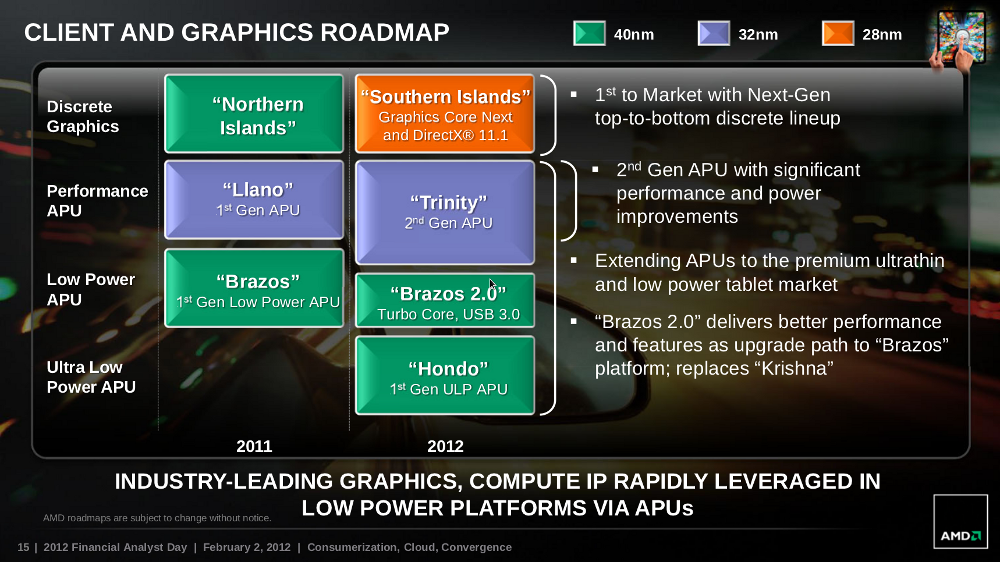
The above slides shows the current offering and upcoming products. Trinity the next generation APU i.e. set to replace the current hot on the heels Llano APU will be launched in the mid of 2012. Somewhat around Computex/ AMD ADFS. Trinity will come in multiple variant i.e. the general desktop/notebook APU and a special BGA (pinless) packed variant under 17-25W range for ultrathins. With 2-4 Piledriver cores and a mix of Northern/Southern Island graphics Trinity will offer double the performance to Llano under same envelop and the same performance under half the power.
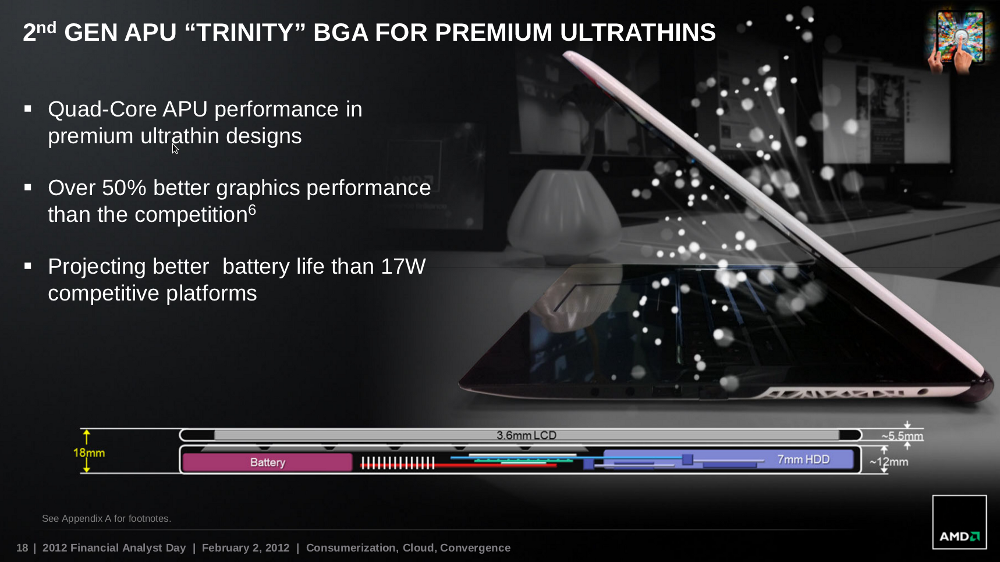
Whats new on the table is Brazos 2.0. AMD tries to make dough by extending the effervescence platform. Providing a new FCH with inbuilt controller for USB SS 3.0 and a double side turbo core working both on GPU/CPU. With Brazos 2.0 AMD will increase the default speed of both the slacer and vector processors.
In 2012, AMD wants to jump into the tablet bandwagon, even though company has been very much into the arena with its low power Desna APU (Z series), but later this year AMD will release tablet specific FCH and UlV Brazos APU named Hondo. The new APU will work at less than 5W TDP (4.5W) and will aims to catch up with Windows 8 tablets in the markets by that timeframe. Trinity will be 32nm SOC chip built by Global Foundaries and IBM.
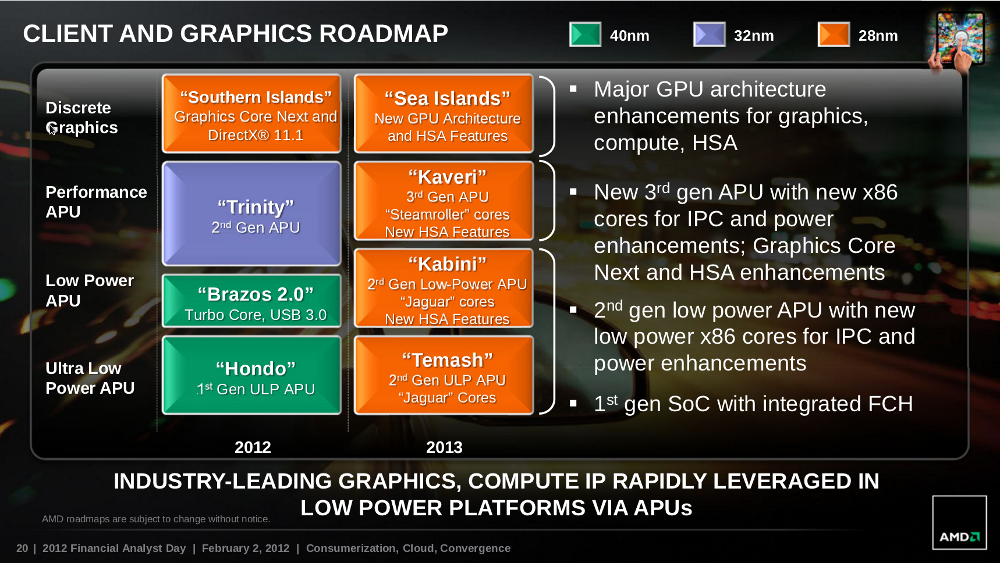
2013 will be the year of major rework for AMD as whole APU roadmap will shift to a lower node process 28nm. The upcoming Trinity APU will be replaced by Kaveri APU featuring the next generation Steamroller CPU and GCN graphics processor. Kaveri will be the first APU to bring HSA to the table making working with memory for suave and more integrated. It is said to have computer power of 1 Teraflop.
Next in line is Kabini and Temash, the first complete SOC by AMD. These chips will feature next generation bobcat core named Jaguar. Built on 28nm processing unit these will offer more performance to the table and better power envelop. Lisa Su said "they will be aiming under 2W TDP with Temash". Being an SOC, it will house everthing under a same chip i.e. CPU, GPU, Memory controller, North/South bridge, UVD block and many more.
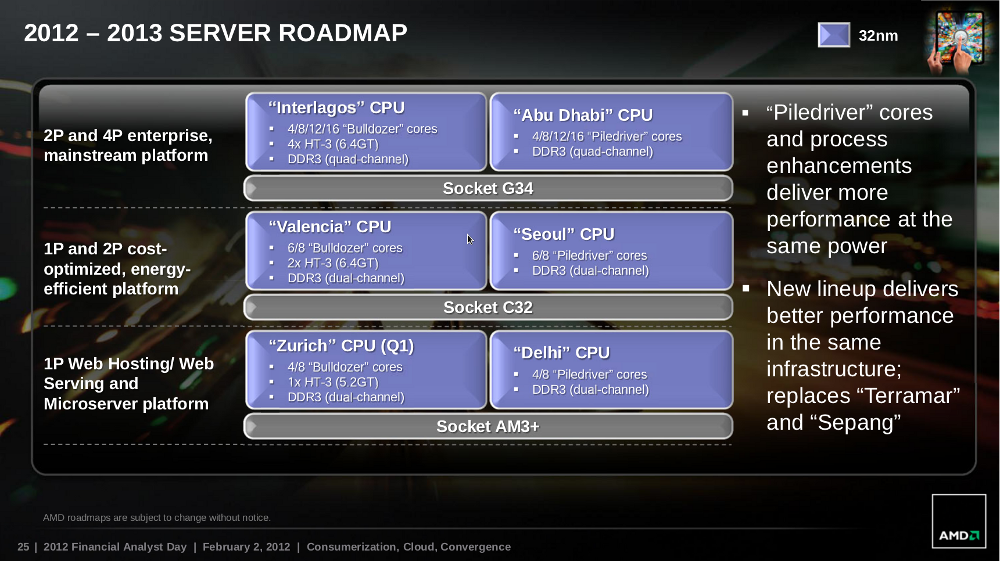
Server is another market AMD will be aiming at. Even though they won't shift to anytime sooner, a piledriver refresh is what AMD will release in second half of 2012. A new Zurich 1P processors will released in around March timeframe aiming at low end server market. Analyst predict that AMD will directly be jumping onto 14nm as the fabless company doesn't have any viable option till then. What has changed is the AMD plans to canel 10-20 core based Sepang and Tremmar core and focus more in IPC than adding core.
AMD plans to release an AM3+ based solution named Zurich will focus on low end market and cloud solution.
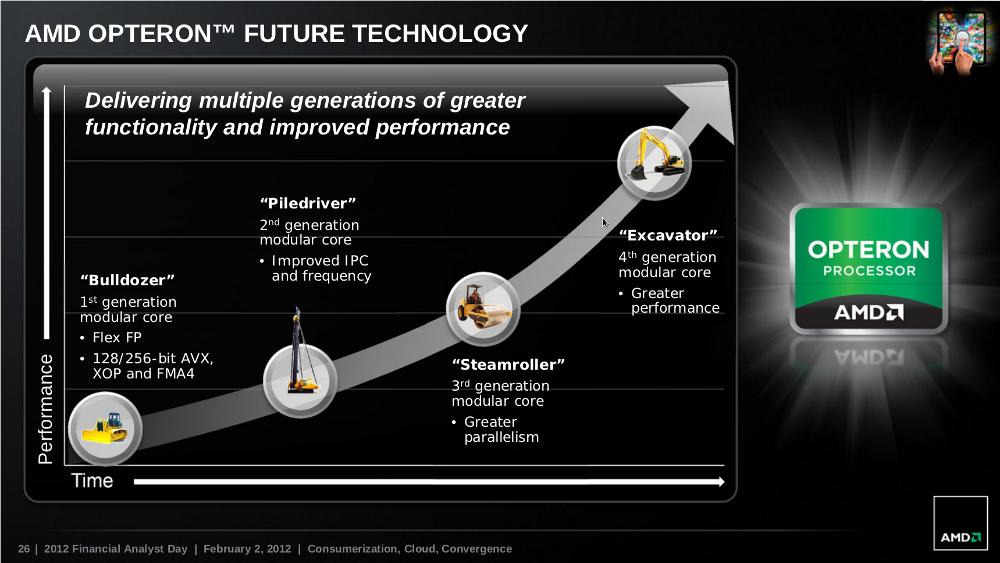
Moving forward AMD will constantly update both server and client desktop cpu architecture with improved performance and power. It is expected that the Excavator will be based on 14nm Fully depleated SOI process. For 2013 AMD will be clinging to its Piledriver based alternatives and sticking to value for money strategy than brute performance.
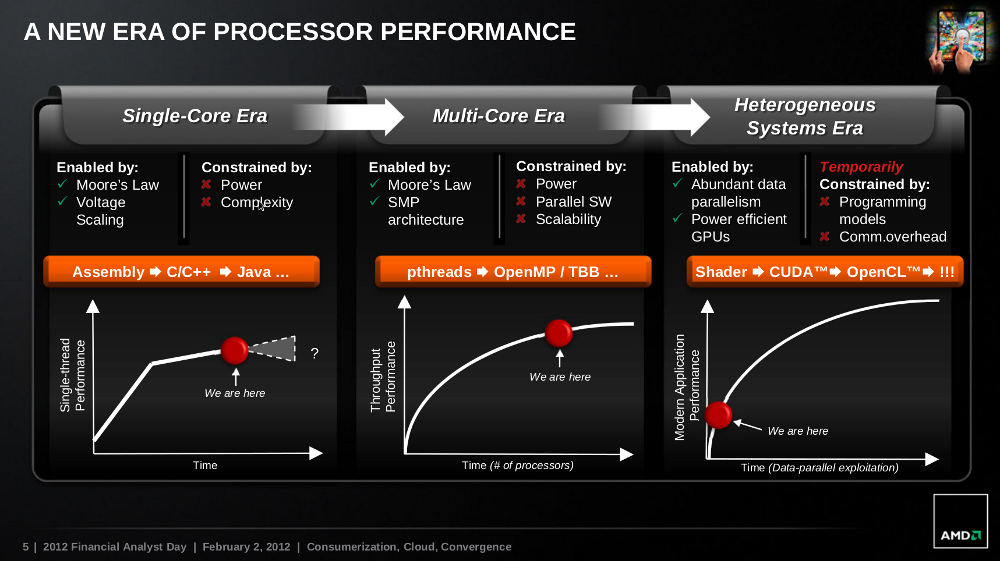
HSA or Hetrogeneous System Architecture aims to leverage how CPU and GPU interact with the memory and leveraging the system in a more integrated manner. Currently the data has to moved to and fro in memory from CPU -> Memory -> GPU in an APU solution, but HSA, AMD aims to implement special fibers which will relentless let both CPU and GPU to access data as they like without creating a bottleneck.
On the demo side AMD displayed that upcoming Trinity APU will feature eye finity with upto 5 display and a unique concept called Lightningbolt. The new I/O technology will seamlessly allow multiple workloads with single cables i.e. charging of devices, transfer of data (usb 3.0 speed), playing Blue ray content and many more using a display port like cables .
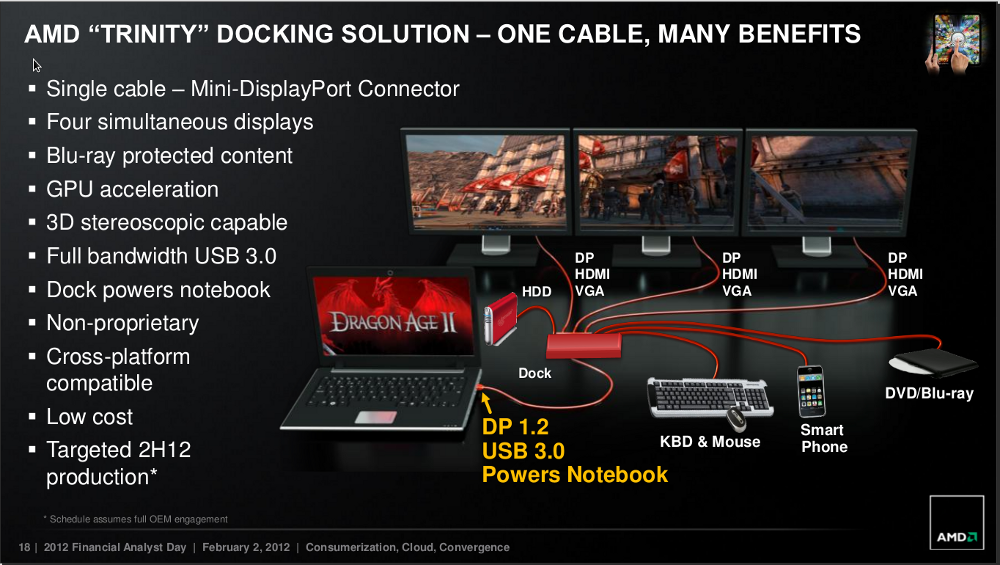
In 2012 AMD will aim to give Intel a tough challenge in both netbook and ultra segment by releasing the Trinity and Brazos 2.0 platform. With Trinity graphics performance surpassing Intels current offering by 50% under same envelop and creating systems under less price, AMD Trinity might pull a win over the very sleek ultrabooks. Stay tuned for more details in upcoming future.
Short news up - Trinity APU will be built on 32nm SOI.
All the 28nm APU will shift to BULK process.
Source. AMD.com
Watch the webcast and slides - http://ir.amd.com/ph...-2012analystday
Click here to view the article
Finally after a year gap AMD held its finacial analyst day at its headquarters.
Focused on execution and SOC strategy and fueled by their HSA (Heterogeneous System Architecture), the company aims to up the ante and snatch the much needed market share. Piling on the success and momentum their first generation APU (Brazos and Llano) created, the company aims to thrive further on similar products by further leveraging on complete system level.
AMD laid out its future plans and roadmaps for the current and upcoming year.
The GM of Global Business Unit, Lisa Su reveled AMD roadmap and hinted that the company will do much better in upcoming year. With a major rework to the roadmap and shelling out products that won't do any benefits. Overall the current roadmap looks much sleeker.

The above slides shows the current offering and upcoming products. Trinity the next generation APU i.e. set to replace the current hot on the heels Llano APU will be launched in the mid of 2012. Somewhat around Computex/ AMD ADFS. Trinity will come in multiple variant i.e. the general desktop/notebook APU and a special BGA (pinless) packed variant under 17-25W range for ultrathins. With 2-4 Piledriver cores and a mix of Northern/Southern Island graphics Trinity will offer double the performance to Llano under same envelop and the same performance under half the power.

Whats new on the table is Brazos 2.0. AMD tries to make dough by extending the effervescence platform. Providing a new FCH with inbuilt controller for USB SS 3.0 and a double side turbo core working both on GPU/CPU. With Brazos 2.0 AMD will increase the default speed of both the slacer and vector processors.
In 2012, AMD wants to jump into the tablet bandwagon, even though company has been very much into the arena with its low power Desna APU (Z series), but later this year AMD will release tablet specific FCH and UlV Brazos APU named Hondo. The new APU will work at less than 5W TDP (4.5W) and will aims to catch up with Windows 8 tablets in the markets by that timeframe. Trinity will be 32nm SOC chip built by Global Foundaries and IBM.

2013 will be the year of major rework for AMD as whole APU roadmap will shift to a lower node process 28nm. The upcoming Trinity APU will be replaced by Kaveri APU featuring the next generation Steamroller CPU and GCN graphics processor. Kaveri will be the first APU to bring HSA to the table making working with memory for suave and more integrated. It is said to have computer power of 1 Teraflop.
Next in line is Kabini and Temash, the first complete SOC by AMD. These chips will feature next generation bobcat core named Jaguar. Built on 28nm processing unit these will offer more performance to the table and better power envelop. Lisa Su said "they will be aiming under 2W TDP with Temash". Being an SOC, it will house everthing under a same chip i.e. CPU, GPU, Memory controller, North/South bridge, UVD block and many more.

Server is another market AMD will be aiming at. Even though they won't shift to anytime sooner, a piledriver refresh is what AMD will release in second half of 2012. A new Zurich 1P processors will released in around March timeframe aiming at low end server market. Analyst predict that AMD will directly be jumping onto 14nm as the fabless company doesn't have any viable option till then. What has changed is the AMD plans to canel 10-20 core based Sepang and Tremmar core and focus more in IPC than adding core.
AMD plans to release an AM3+ based solution named Zurich will focus on low end market and cloud solution.

Moving forward AMD will constantly update both server and client desktop cpu architecture with improved performance and power. It is expected that the Excavator will be based on 14nm Fully depleated SOI process. For 2013 AMD will be clinging to its Piledriver based alternatives and sticking to value for money strategy than brute performance.

HSA or Hetrogeneous System Architecture aims to leverage how CPU and GPU interact with the memory and leveraging the system in a more integrated manner. Currently the data has to moved to and fro in memory from CPU -> Memory -> GPU in an APU solution, but HSA, AMD aims to implement special fibers which will relentless let both CPU and GPU to access data as they like without creating a bottleneck.
On the demo side AMD displayed that upcoming Trinity APU will feature eye finity with upto 5 display and a unique concept called Lightningbolt. The new I/O technology will seamlessly allow multiple workloads with single cables i.e. charging of devices, transfer of data (usb 3.0 speed), playing Blue ray content and many more using a display port like cables .

In 2012 AMD will aim to give Intel a tough challenge in both netbook and ultra segment by releasing the Trinity and Brazos 2.0 platform. With Trinity graphics performance surpassing Intels current offering by 50% under same envelop and creating systems under less price, AMD Trinity might pull a win over the very sleek ultrabooks. Stay tuned for more details in upcoming future.
Short news up - Trinity APU will be built on 32nm SOI.
All the 28nm APU will shift to BULK process.
Source. AMD.com
Watch the webcast and slides - http://ir.amd.com/ph...-2012analystday
Click here to view the article

